When Sightline launched its policy research program to study and promote solutions for affordability and green urbansim, we poked at the prevailing narratives about housing, and it felt a lot like stirring a hornet’s nest. It wasn’t just the euphemistic anti-renter, anti-housing rhetoric about preserving “neighborhood character.” Dominant opposition messages menaced with imagery of bulldozers, chainsaws, and the end of your city as you know it. And don’t forget that it was our erstwhile friends on the left who often agitated to prioritize parking spots over protecting people and places. Finding better ways to talk about zoning reform felt daunting.
Little by little, and arm in arm with a growing network of abundant housing advocates, we’re pushing out the old narratives and making room for solutions-centered ones.

But, little by little, and arm in arm with a growing network of abundant housing advocates, wonks, and leaders, we’re pushing out the old obstructionist narratives and making room for new solutions-centered ones. As we close out 2019, the hornets are still around, but theirs is no longer the only buzz you hear.
Starting about 3 years ago, we began collecting others’ research and doing our own, focus-grouping and road testing messages, gleaning and sharing everything we could along the way. From granny flats to exclusionary zoning, here is the cache of resources that we’ve built up, all in one place for the first time:
Talking Points: Why State-Wide Housing Solutions Matter
The severe housing shortage in Washington is hurting families and communities in every corner of the state. And the fact is, even with many cities stepping up and doing everything they can, local jurisdictions still struggle to enact solutions that will make a dent in the problem. No city can fix this alone. The answer is state-level leadership. States set standards all the time to protect their residents’ health, safety, and well being. Think: auto emissions and speed limits, or state-wide growth management standards for cities and counties to protect farms and forests. Real progress on housing affordability requires the same kind of coordinated state-wide effort. Click here for the full memo.
Missing Middle Reframes: Lessons from Oregon’s State-wide Upzone Success
 Words matter. We suggest replacing “single-family” with “single-detached.” And instead of talking in jargon about “units” and “multi-family housing,” switch to “homes” or “choices of all shapes and sizes,” and descriptive terms like duplexes, triplexes, and apartments. Find more reframes and talking points in our full messaging memo.
Words matter. We suggest replacing “single-family” with “single-detached.” And instead of talking in jargon about “units” and “multi-family housing,” switch to “homes” or “choices of all shapes and sizes,” and descriptive terms like duplexes, triplexes, and apartments. Find more reframes and talking points in our full messaging memo.
Put a Friendly Face on Gentle Density: Our open-source photo library of home choices in all shapes and sizes
Most people believe, in principle, in expanding opportunity and affordability. But if left to the imagination, multi-family housing can sound too big, unfamiliar, and even scary. Showing what missing middle homes look like helps tame exaggerated fears. Find our tips for putting missing middle homes in their best light—and hundreds of photos to use in your own work. And let us know if you have photos to add!
Exclusive Zoning Puts Up Invisible Walls Around Our Cities: Talking points for upzone solutions
Our video explains in under 2 minutes how exclusionary zoning puts up invisible walls and locks people out, banning affordable home choices close to work, school, friends, parks, and transit. Commutes get longer and we get more traffic and pollution. And cities are segregated. Upzoning to allow more home choices opens the gates to affordability and opportunity. What’s upzoning? It means protecting a healthy mix of homes of all shapes and sizes—and for all incomes—throughout our neighborhoods, including lifting bans on rental options and more affordable homes like duplexes, backyard cottages, and apartments. Find the video here.
Why Mother-In-Laws Matter: From economic security and affordability to sustainability, talking up the benefits of ADUs.
Small apartments in existing neighborhoods—often in existing homes or structures—offer multiple benefits, including adding affordable options for renters in single-detached areas where prices are otherwise out of reach. Here’s our guide for communicating about this low-impact, common-sense affordability solution. You can find the whole guide here.
Talking Triplexes: Missing middle messaging tips
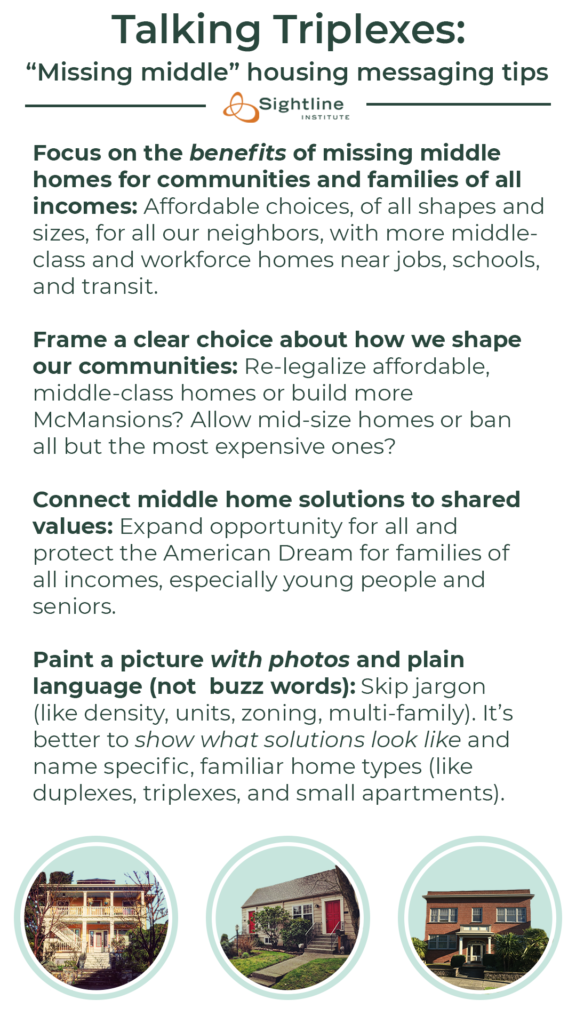 Re-legalizing a variety of modest, mid-size home choices, like duplexes, triplexes, and quads in residential city neighborhoods, protects mixed income communities from becoming exclusive McMansion enclaves. Zoning that allows “missing middle” homes curbs prices and gives moderate-income, working families and small households like seniors or young couples more affordable options. Find the full memo here.
Re-legalizing a variety of modest, mid-size home choices, like duplexes, triplexes, and quads in residential city neighborhoods, protects mixed income communities from becoming exclusive McMansion enclaves. Zoning that allows “missing middle” homes curbs prices and gives moderate-income, working families and small households like seniors or young couples more affordable options. Find the full memo here.
Do People Object to Development—or Mostly Developers Making Money?
Opposition to new homes can hobble community goals for affordability and sustainability. But what if people dislike development because they don’t like to see developers profit? And what if the rules that result—ones that punish homebuilders—in reality encourage only the most deep-pocketed, aggressive developers, preclude all but the most expensive kinds of homes, and wind up punishing the community instead? Here’s our take on a UCLA study showing that a desire to punish developers drives anti-homebuilding attitudes.
More Homes, All Shapes and Sizes, for All Our Neighbors
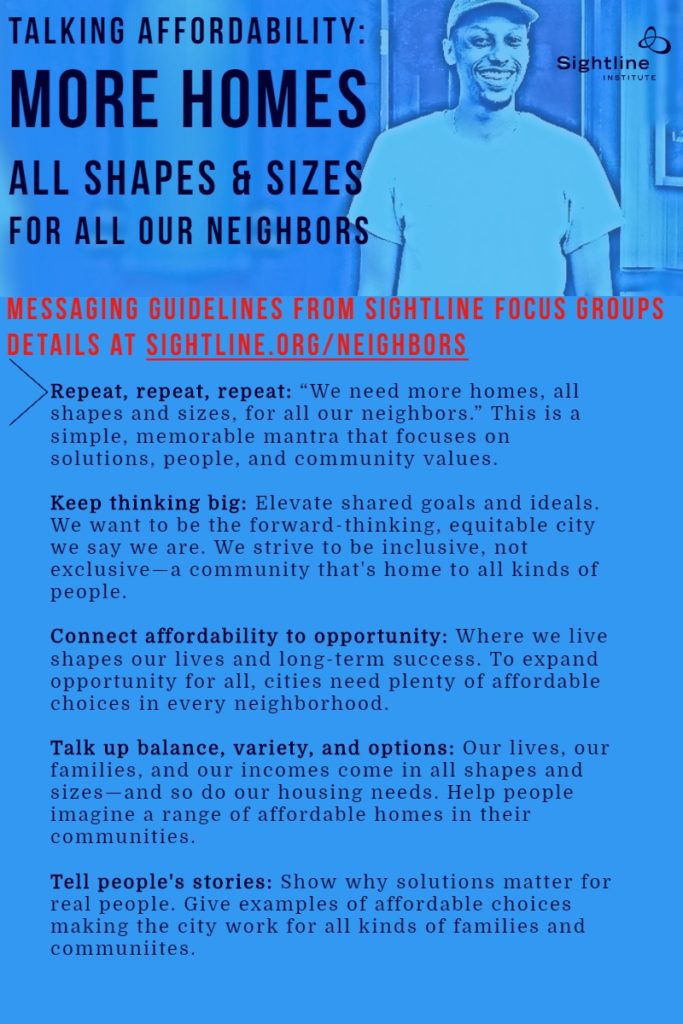 In focus groups we conducted in Seattle, we found that saying “more homes, all shapes and sizes” to talk about housing solutions toggled people toward community-minded, big-hearted thinking—about community, neighbors, inclusion. The idea stuck with focus group participants (they repeated it back to us), and it proved an especially compelling case for changing city rules to allow plenty of homes to go around and a variety of homes for all kinds of people. Find more messaging guidelines from Sightline’s focus groups here.
In focus groups we conducted in Seattle, we found that saying “more homes, all shapes and sizes” to talk about housing solutions toggled people toward community-minded, big-hearted thinking—about community, neighbors, inclusion. The idea stuck with focus group participants (they repeated it back to us), and it proved an especially compelling case for changing city rules to allow plenty of homes to go around and a variety of homes for all kinds of people. Find more messaging guidelines from Sightline’s focus groups here.
Talking Housing Affordability: Getting from “Me” to “We”
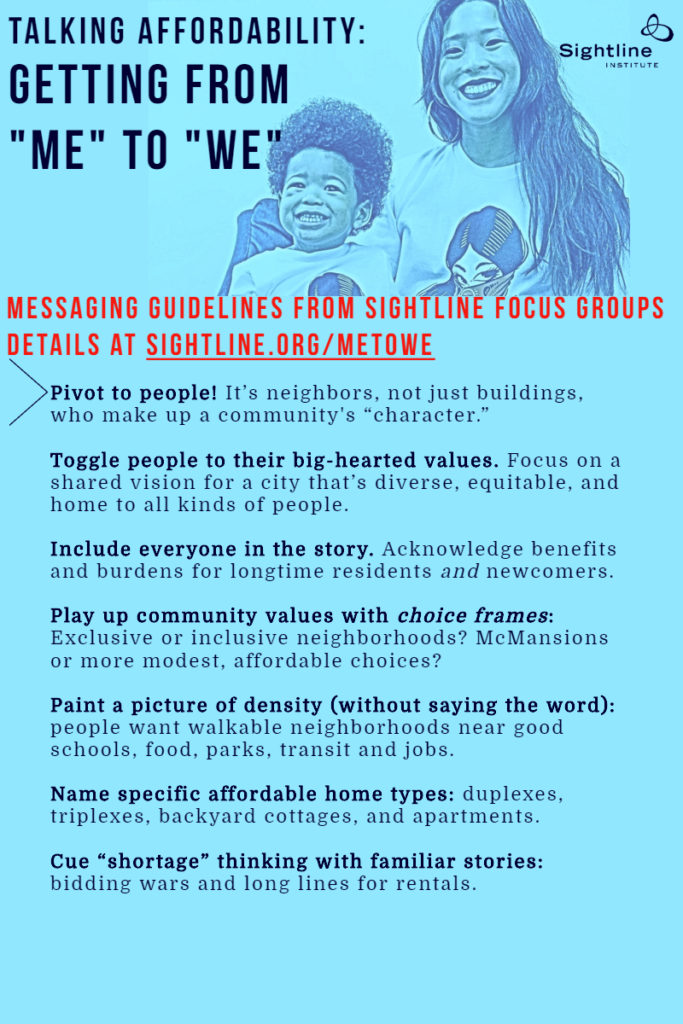 We learned from focus groups in Seattle that people are anxious about growth and change—renters and homeowners alike—and they see developers as the problem, not part of the solution. In this context, it’s difficult to cast building as key to keeping prices down. But we found opportunities to open minds to abundant housing solutions. For one, shifting the focus to neighbors (not buildings) helped people think about how home choices determine who can or cannot afford to live in a community. We found out that people like density in practice—walkable, convenient places to live—but dislike the word. So, better to describe density than use the word! More findings from our focus groups that help shift the conversation here.
We learned from focus groups in Seattle that people are anxious about growth and change—renters and homeowners alike—and they see developers as the problem, not part of the solution. In this context, it’s difficult to cast building as key to keeping prices down. But we found opportunities to open minds to abundant housing solutions. For one, shifting the focus to neighbors (not buildings) helped people think about how home choices determine who can or cannot afford to live in a community. We found out that people like density in practice—walkable, convenient places to live—but dislike the word. So, better to describe density than use the word! More findings from our focus groups that help shift the conversation here.
“Let’s Own Our Growth!”—A housing narrative that centers equity and shared opportunity
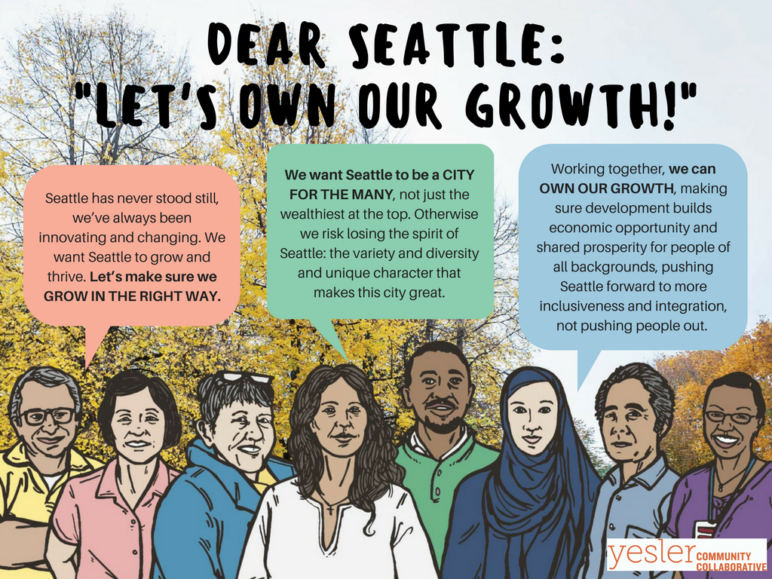 A messaging research project in Seattle by Yesler Community Collaborative revealed broadly shared goals of expanding social, racial, and economic equity and sharing the progress and prosperity of a thriving, healthy city. Their talking points emphasize growing to make sure we build cities for the many, not just the wealthiest few. Owning our growth means shaping a city where everyone can share in the opportunity of growth and prosperity. Our cheatsheet for this narrative project is here.
A messaging research project in Seattle by Yesler Community Collaborative revealed broadly shared goals of expanding social, racial, and economic equity and sharing the progress and prosperity of a thriving, healthy city. Their talking points emphasize growing to make sure we build cities for the many, not just the wealthiest few. Owning our growth means shaping a city where everyone can share in the opportunity of growth and prosperity. Our cheatsheet for this narrative project is here.
A Blueprint for Better Housing Messages
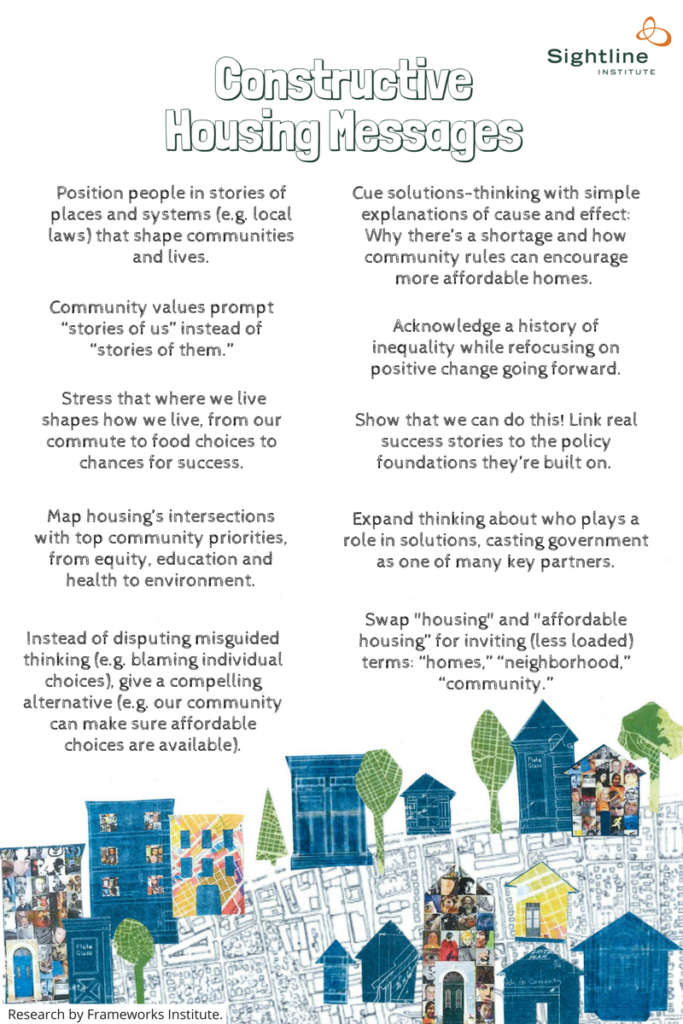 FrameWorks Institute found six common ways housing messages can backfire and ten constructive reframes, like swapping “housing” and “affordable housing” for inviting (less loaded) terms like “homes,” “neighborhoods,” and “communities.” They suggest acknowledging a history of inequality and focusing on better ways forward and stressing that where we live shapes how we live, from our commute to food choices to chances for success. Find a summary of Frameworks’ research and talking points in our Flashcard.
FrameWorks Institute found six common ways housing messages can backfire and ten constructive reframes, like swapping “housing” and “affordable housing” for inviting (less loaded) terms like “homes,” “neighborhoods,” and “communities.” They suggest acknowledging a history of inequality and focusing on better ways forward and stressing that where we live shapes how we live, from our commute to food choices to chances for success. Find a summary of Frameworks’ research and talking points in our Flashcard.
6 Tips for Talking Housing Solutions
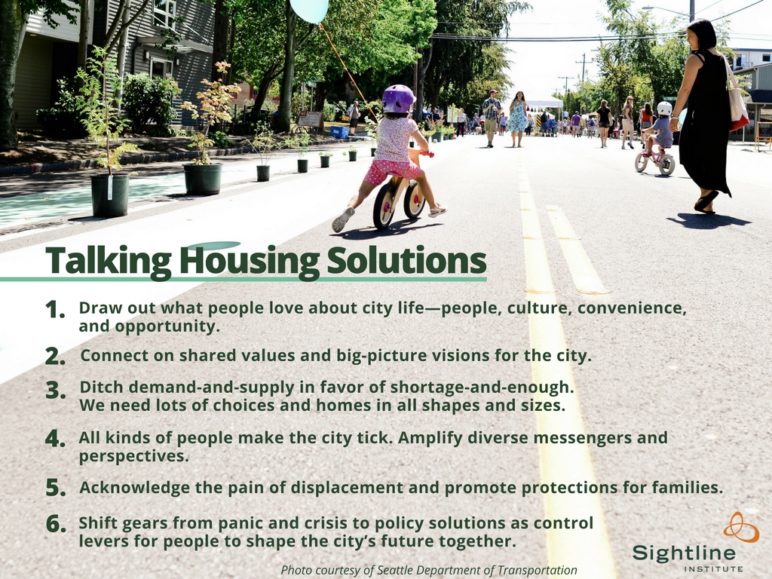 Sightline’s audit of Seattle media coverage of housing issues revealed that growth was often cast as out of control and scary. Despite rancor over decisions that might invite more change, we found evidence that Seattleites were unified in shared hopes and dreams for their city—including income and racial diversity and expanded opportunity and access—core values and community priorities that could help align voters behind abundant housing solutions. We pulled 6 lessons from the exercise: 1) remind people what they love about the city; 2) emphasize shared values; 3) ditch supply and demand for shortage and enough; 4) amplify diverse voices; 5) abundant housing solutions are a foundation for successful displacement protections; and 6) ease panic by shaping solutions together. More tips from our media audit are here.
Sightline’s audit of Seattle media coverage of housing issues revealed that growth was often cast as out of control and scary. Despite rancor over decisions that might invite more change, we found evidence that Seattleites were unified in shared hopes and dreams for their city—including income and racial diversity and expanded opportunity and access—core values and community priorities that could help align voters behind abundant housing solutions. We pulled 6 lessons from the exercise: 1) remind people what they love about the city; 2) emphasize shared values; 3) ditch supply and demand for shortage and enough; 4) amplify diverse voices; 5) abundant housing solutions are a foundation for successful displacement protections; and 6) ease panic by shaping solutions together. More tips from our media audit are here.
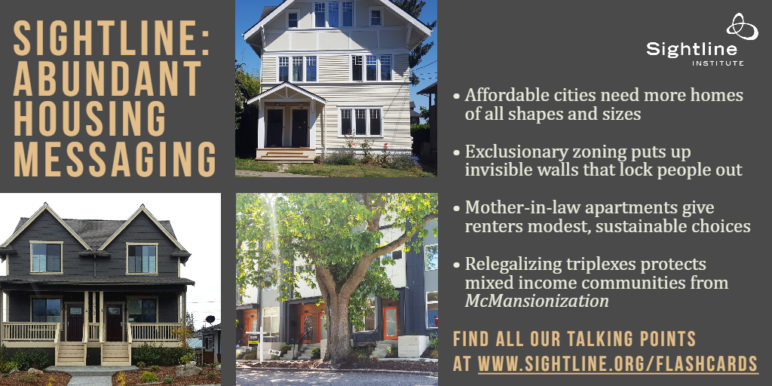
Original Sightline Institute graphic, available under our free use policy.

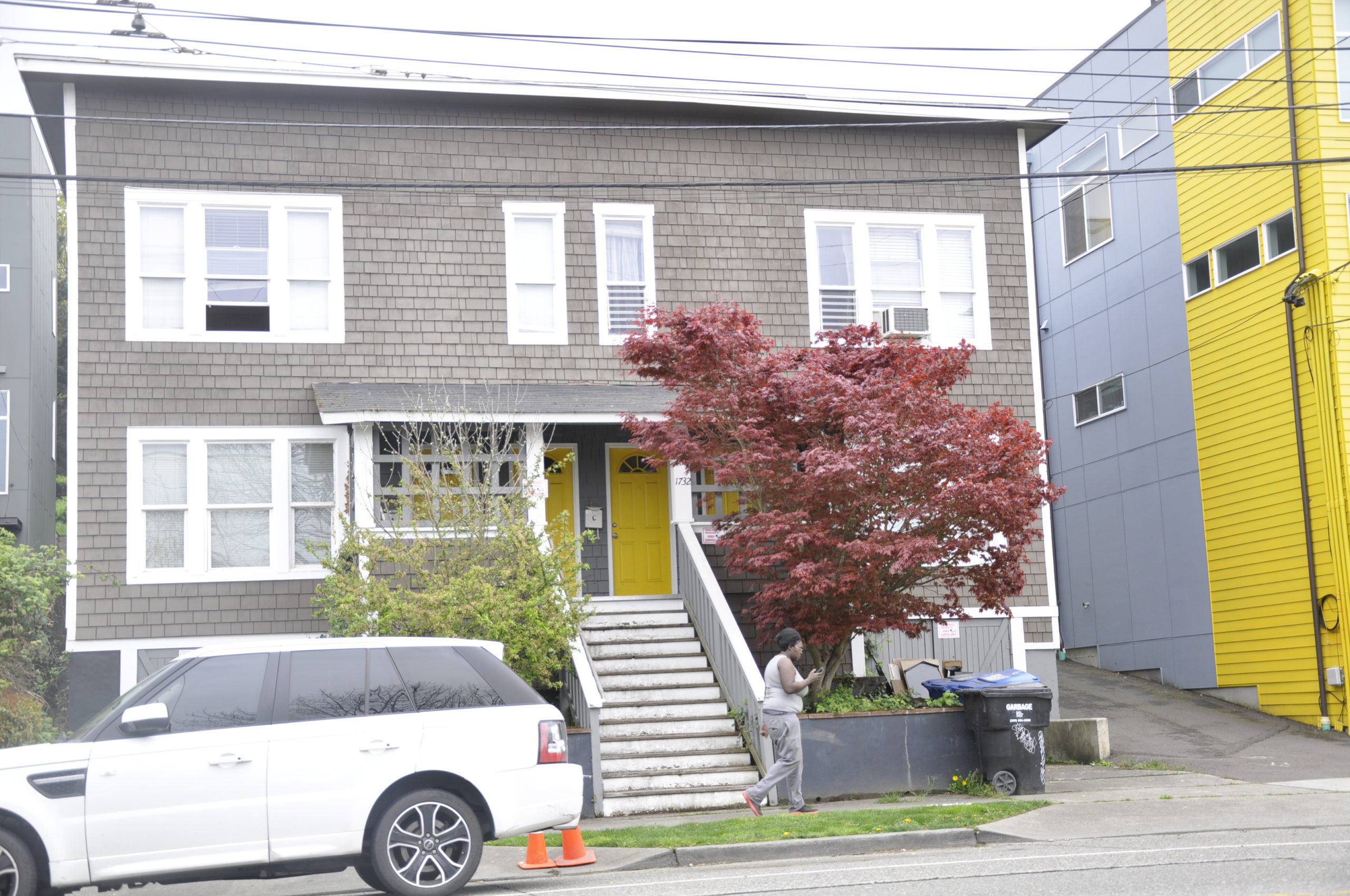
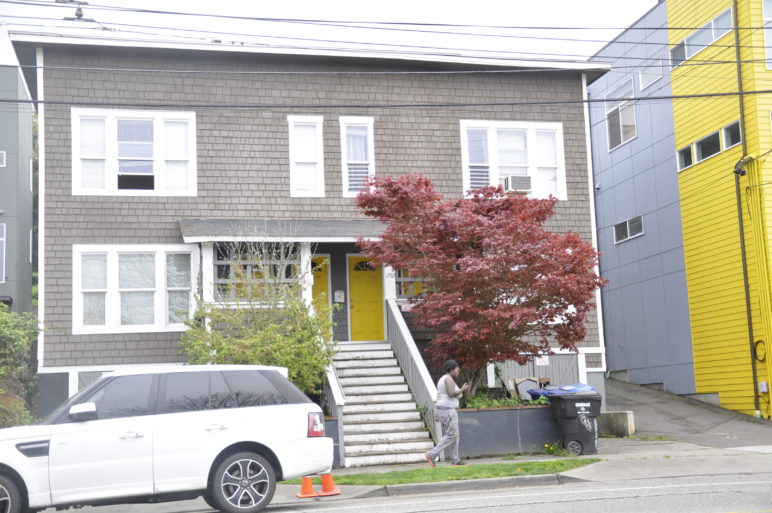









Kim Dobson
Framing Sight line’s message to the public , the code word is sustainable ? In all of these policy talking points , no one has made any guarantees of affordable housing for low income folk ? Many of these “Diverse “folk can not afford the upscale overpriced housing . “opportunities to open minds to abundant housing solutions ” Abundance does not equate to “Affordability ” . In Olympia these so called “Market Rate” rent policies adopted by the Olympia city council for new so called ” Missing Middle zoning “allow landlords to charge what ever they want . Why ? because it’s not profitable for the speculators and Master Builder lobby who lobbied the City planners to create the Missing Middle . Low income housing was never adopted as a mandatory policy in Olympia’s zoning changes . People are being removed from low income apartments in high numbers so land lords can remodel/demolish and triple the rents as gentrification has been codified in city policy . Developers argue that profit margins too low when they are forced by Code to build low income housing . The City of Olympia has been in a court battle with the Growth Management Board 4 times they have lost to the hearing examiners and found to in violation of the State Environment Policy Act (SEPA) ,EIS and Department of Ecology . In response 22nd district Rep Beth Doglio ,City of Olympia and Seattle Master builder Lobbyists crafted HB 1923 which makes it illegal to sue cities who violate the SEPA ,EIS and Ecology Stormwater rules . All the claiming to care about environment degradation caused by increased densely hardened surfaces on lots too small to absorb storm water , polluting creeks and streams with Roundup ,oil , nitrate fertilizers etc running into the Salish Sea . All of your talking points will never explain these facts away . And you all claim to care about the environment and low income folk . Your message is “lets craft the message to gloss over the problems with increased density but not listen to critics and not adjust actual policy to highest available science and just social policy Shame !